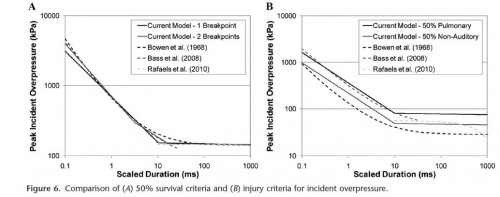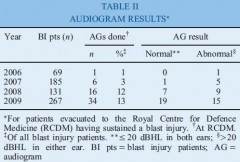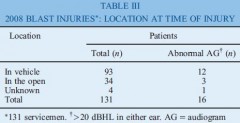18/02/2012
Exposition répétées: Plus graves ! ou ?
Primary blast survival and injury risk assessment for repeated blast exposures
Panzer MB et all. J Trauma. 2012;72: 454–466.
Les conflits afghnas et irakiens ont vu les personnels des armées occidentales confrontées à de nouvelles modalités d'exposition à des ondes de surpression. Leur caractèes répété est responsable de lésions plus graves. Cet article actualise un certain nombre de données.
Ces quelques diagrammes expriment de manière très claire la relation entre le pic de pressions, sa durée et la répétition sur la survie et les lésions observées.
-------------------------------------------------------
BACKGROUND:
The widespread use of explosives by modern insurgents and terrorists has increased the potential frequency of blast exposure in soldiers and civilians. This growing threat highlights the importance of understanding and evaluating blast injury risk and the increase of injury risk from exposure to repeated blast effects.
METHODS:
Data from more than 3,250 large animal experiments were collected from studies focusing on the effects of blast exposure. The current study uses 2,349 experiments from the data collection for analysis of the primary blast injury and survival risk for both long- and short-duration blasts, including the effects from repeated exposures. A piecewise linear logistic regression was performed on the data to develop survival and injury risk assessment curves.
RESULTS:
New injury risk assessment curves uniting long- and short-duration blasts were developed for incident and reflected pressure measures and were used to evaluate the risk of injury based on blast overpressure, positive-phase duration, and the number of repeated exposures. The risk assessments were derived for three levels of injury severity: nonauditory, pulmonary, and fatality. The analysis showed a marked initial decrease in injury tolerance with each subsequent blast exposure. This effect decreases with increasing number of blast exposures.
CONCLUSIONS:
The new injury risk functions showed good agreement with the existing experimental data and provided a simplified model for primary blast injury risk. This model can be used to predict blast injury or fatality risk for single exposure and repeated exposure cases and has application in modern combat scenarios or in setting occupational health limits.
-------------------------------------------------------
05/12/2011
Audition du combattant et blast
Ear injuries sustained by British service personnel subjected to blast trauma
Breeze J. et all. The Journal of Laryngology & Otology (2011), 125, 13–17
Objectives:
To describe the pattern of ear injuries sustained by all British servicemen serving in Iraq and Afghanistan between 2006 and 2009; to identify all servicemen evacuated to the Royal Centre for Defence Medicine following blast injury; to ascertain how many underwent otological assessment; and to calculate the incidence of hearing loss.
Design and setting:
A retrospective analysis of data obtained from the Joint Theatre Trauma Registry and the Defence Analytical and Statistics Agency, together with audiometry records from the University Hospitals Birmingham National Health Service Trust.
Results:
Ear damage was present in 5 per cent of all British servicemen sustaining battle injuries. Tympanicmembrane rupture occurred in 8 per cent of personnel evacuated with blast injuries. In 2006, 1 per cent of servicemen sustaining blast injury underwent audiography; this figure rose to 13 per cent in 2009. Fifty-three per cent of these audiograms were abnormal.
Conclusion:
The incidence of tympanic membrane rupture was higher than that found in previous conflicts. Otological assessment prior to and following military deployment is required to determine the incidence of ear injury amongst British servicemen following blast trauma.
01/01/2011
Balistique terminale: Historique
| Tags : balistique







